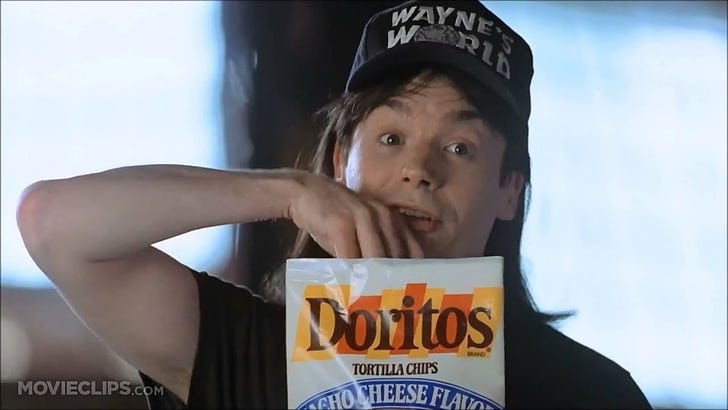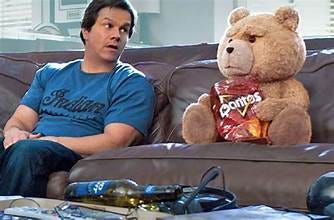Product Placement
Companies pay big money to promote their products in films and on TV, but other times, their products appear, whether they want them to or not.
I know - we’re shameless, right? But, we freely admit that, given the opportunity to lift an image from the movie, Ted, from Google and place it atop a Rule of Three award-winning column, we’re jumping in headfirst. Not only is Ted clutching a bag of Doritos, but, his buddy, John is sporting an Indian Motorcycle t-shirt, and, if I’m not mistaken, that’s an empty Bud Light bottle on the table in front of them. All three companies no doubt paid for their products to be featured in that scene in the film.
But, this is not the only example of paid product placement activity in films or TV shows. Some of the more recognizable instances include:
Marty McFly steps into a pair of self-lacing Nike shoes, in Back to the Future - I think we can count this as product placement, even though the self-lacing Nike shoes were not commercially available at the time. Nike was also spotlighted in Forrest Gump and White House Down - research must have shown Nike that moviegoers are the proper target market for them. Back to the Future contained many other product placements, including: Calvin Klein (purple underwear), Converse (Chuck Taylor High Top sneakers) and, lest we forget, the DeLorean automobile, with its distinctive gull-wing doors. It has been suggested to me that the DeLorean Motor Company doubled its annual vehicle sales, due to the massive publicity provided by the film’s popularity - that’s right, they sold a total of six DeLoreans in 1985, apparently - fun with math! (Ed. note: These sales figures are merely estimates - they could not be independently verified).
The film Cast Away prominently features FedEx, although you could argue that highlighting the downing of a FedEx airplane, and stranding one of its executives on a desert island for a very long time might not have reinforced the brand image desired. Also, don’t forget about another key character in that movie: “Wilson,” so named because the volleyball Tom Hanks befriends was produced by Wilson Sporting Goods.
Ray-Ban sunglasses were featured in not one, but two iconic movies starring Tom Cruise, released in the 1980’s: first, in Risky Business, and, a few years later, in Top Gun. Sales of Ray-Bans experienced large spikes, tied to the release of both movies. And, no, I have no idea what brand of underpants Cruise was wearing during the “Old Time Rock and Roll” scene - they clearly were not purple Calvin Kleins.
Reese’s Pieces were an integral component in Steven Spielberg’s E.T. the Extra-terrestrial, but only because the Mars, Inc. candy company turned up its nose at having its product, M&M’s, featured in the film - Hershey, the maker of Reese’s Pieces, didn’t mind being the second choice.
A popular Friends episode revolves around Rachel’s obsession with Pottery Barn - it might as well have been a 30-minute commercial for Pottery Barn.
And, Sex And the City’s character, Carrie Bradshaw, was obsessed with Manolo Blahnik designer shoes, to the point that the shoes were mentioned in sixteen of the show’s 94 episodes.
Seinfeld put its own unique spin on product placement, as an episode featured the character, Kramer, dropping a Junior Mint into a patient’s open chest, during surgery - “It’s very refreshing.”
One of my personal favorites is a scene in Wayne’s World, which pokes fun at the business of product placements - it clearly warrants including the Youtube clip right here and now - enjoy. . .
But, sometimes a company’s product is featured unwittingly on television. An example with which you are likely familiar is that of Ford Motor Company, whose popular Bronco SUV was spotlighted during an extended, slow-speed journey on Los Angeles freeways the afternoon of June 17, 1994. That white Bronco was being driven by Al (A.C.) Cowlings, as he ferried his pal, O.J. Simpson, who was suspected of the murder of his ex-wife, Nicole, and her friend, Ron Goldman, on an hour-long sojourn, which eventually ended at Simpson’s Brentwood estate. I’m sure Ford executives were wondering why A.C. couldn’t have opted for a Chevrolet Blazer, or a Dodge Ramcharger.
Another notorious example of unwanted attention affected Johnson & Johnson, the makers of pain reliever, Tylenol. Seven people in the Chicago area died from cyanide poisoning in 1982, in a case of product tampering. The case has never been officially solved, although a man was convicted of extortion for sending a letter to Johnson & Johnson, demanding $1 million to stop the killings. That tamper-proof packaging that you and I struggle with, when attempting to open bottles of medication and other products was an outgrowth of this terrible incident.
Proctor & Gamble also received unexpected buzz in 2018, as the “Tide Pod Challenge” became an internet sensation, in a bad way. The challenge involved ingesting this product, which, I find it necessary to point out, is a laundry detergent product, and is not in any way intended to be a food product.
Samsung faced a product crisis as well, back in 2016, when news surfaced that its Galaxy Note 7 smartphone occasionally burst into flames. Beyond the editing oversight which resulted in this feature not being clearly detailed in its user manual, Samsung also faced a public relations issue, because, you know, the phone occasionally burst into flames. The problem was tied to the use of lithium ion battery packs, which should scare the bejesus out of us (I wanted to spell this word, “bejeezus,” but couldn’t find any self-respecting online dictionary agreeing to my request - “bejesus” just seems weird to me), because lithium ion battery packs continue to power virtually every smartphone in use today. Sleep well.
Finally, I’m not sure how best to characterize this experiment, which, unless you’ve found yourself stranded on a desert island for a very long time, like Tom Hanks in Cast Away, you’ve certainly heard about. The experiment was first publicized on the Late Show with David Letterman in 1999, and, has been given oxygen by the internet and social media ever since. That’s right, I’m talking about the “Coke and Mentos Experiment.” I doubt if The Coca-Cola Company, or the maker of Mentos initially endorsed this experiment, or if any money changed hands regarding this adventure, but, it clearly became a part of the zeitgeist of the early 2000’s. Again, I’m unsure where exactly to file this one, but, below is one example of the “Coke and Mentos Experiment” in action - enjoy. . .
We here at Rule of Three are currently reviewing film scripts, with the intention of securing a significant product placement deal. Our marketing team insists upon featuring the product in a professional and tasteful manner, which serves to reinforce the brand equity. And, we will absolutely not consider nudity, unless, you know, it’s tastefully done, is integral to the storyline and serves to advance the narrative arc.
Rule of Three will never ask you remove your clothes in order to consume its product offerings. Click the button below to subscribe now (and, keep your clothes on) - also, it's free, man!




Very interesting observations. You've inspired me to pay more attention to the smaller details than I usually do. Thanks, Bill.
Love the concept of how many product placements can be spotted in one scene! I also wonder about the inadvertent negative "product" placements, particularly settings for TVs and movies. Will the Ozarks and Albuquerque ever recover from their depiction in the show Ozark and Breaking Bad?